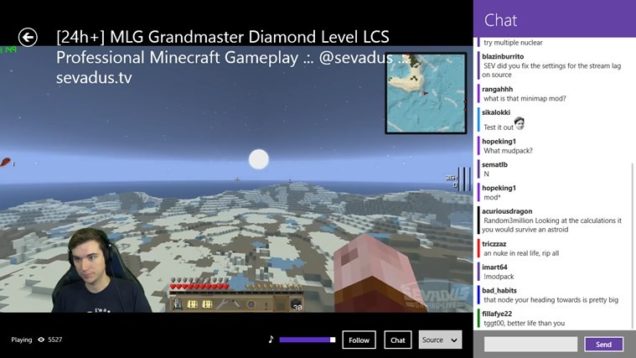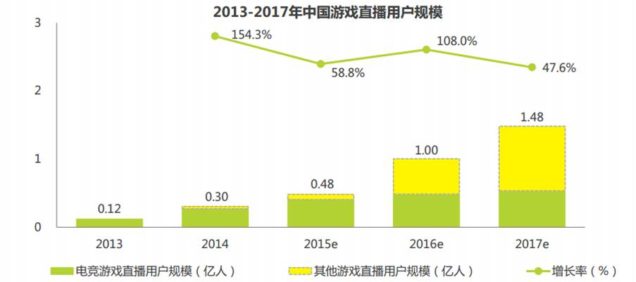Twitch.tv has been in the spotlight and front line of live streaming services ever since it first came out in 2011, as a video game focused spin off of the original multi-purpose live streaming service Justin.tv. Based on its enormous growth in business size, the mother company, Justin.tv, actually closed the original Justin.tv website in 2014, so the company can focus all its resources and attentions on Twitch.tv. Ironically, the site project became the actual project.
According to the Wall Street Journal, in 2014 Twitch.tv had more than 55 million regular watcher monthly, and only shy to Netflix, Google, and Apple in terms of internet peak traffic in the United States, with 1.8%. The growth of Twitch.tv also triggered side effects such as professional streaming is now an actual career choice, standing side by side with traditional career choices such as engineer. The explosive growth of Twitch.tv is not only representing the development of one live streaming service website, but also signals the uprising of the entire live streaming industry across the world. 2011 is the exact year that E-Sport took off as well, with the first ever 1 million dollar prize tournament. There is a strong linkage between the live streaming industry and E-Sport, that E-Sport is a strong pushing force in the success of live streaming websites such as Twitch.tv in the United States and Douyutv in China.
Even though according to BBC NewsNight, game live streaming services as a whole is changing the media landscape, The core components of game live streaming services are actually not so different from traditional streaming video and streaming TV services. According to Gentzkow’s study on television influence on politics and de Boer, Suetfeld, and Groshek’s study on YouTube political contents, content difference and cultural differences are the keys within traditional media platforms, it is the same for new live streaming services such as Twitch.tv as well (Gentzkow, 2005; de Boer, Suetfeld, & Groshek, 2012).
In fact, content difference is the distinguishing element between new live streaming services such as Twitch.tv and traditional streaming TV. The different contents showed by different services result in the different types attractions to the audience. The identifying element for streaming TV and streaming video service content and game live streaming content is whether the content is active or passive: for traditional TV services, the content requires a passive viewing experience, while streaming video and streaming TV services made the content can be actively engaged; and for traditional game experience, the content need active engagement, while watching the game stream is a passive approach to the content (Smith, Obrist, & Wright, 2013). The differences in content caused the different approaches, while those different approaches caused different attractions to different audience, which it why game live streaming services is changing media landscape: it is addressing an area of issues that had never been addressed before.

The key difference between new game live streaming and traditional streaming video/ TV is the difference in content, therefore content matters. However, the difference between different new live streaming services is not the content anymore, it is the culture instead. BBC NewsNight addressed the idea that Chinese people are very passionate on game live streaming services in its video, this idea pushed Chinese game live streaming service to a different level comparing to the United States game streaming. According to the data from the Wall Street Journal, Twitch.tv is already huge, but the leading Chinese game streaming service, Douyutv, is even bigger. According to Southern China Morning Post, Douyutv has 15 million daily active users across its platforms, achieving more than 27% of Twitch.tv’s monthly traffic in only a day (He, 2016). It is worth noticing that this comparison is based on the data of Twitch.tv from 2014, but it is also crucial that Douyutv was founded in 2013, two years after Twitch.tv. Therefore, it is more or less a fair comparison. Plus, it is also worth noticing that while Twitch.tv is the dominating force in the United States and European game streaming industry, Douyutv has very competitive competitors such as Panda.tv and Bilibili Live.

2013-2017 Chinese game live streaming user extent (Counting Unit: hundred million)
The quicker growth Chinese game streaming industry than Twitch.tv is caused by the cultural differences between China and the United States. It is no longer a secret that Asian, especially Chinese people, rate education far higher than other curriculum. Chinese people not only pay more attention on education than typical Americans, but also even perceive education more important than other Asian cultures. Hence, such opinion is increasingly significant for elder generations (Goyette & Xie, 1999). This caused a very negative attitudes towards video games, especially for the parents of the current dominating online user population. The current generation of Chinese people normally had no access towards video games on consistent basis in welcoming environment. Therefore, comparing to American stream watchers, the change in the adaptation of the content is not from active to passive, it is from nonexistence to existence. This cultural difference partially caused the “boom” of Chinese game streaming industry.
Swickert, Hittner, Harris, and Herring identified individual internet usage as a type of leisure, and such leisure is influenced by individual and cultural differences (Swickert, Hittner, Harris, & Herring, 2002). Based on the nature of video games and streaming video/ TV, it is fairly safe to say that game live streaming such as Twitch.tv is also a leisure, just like Gentzkow’s take on television. While Gentzkow identify television has generally been “bad,” I do not think it is the same for Twitch.tv. First of all, it is really hard to identify the nature of such as new born industry. Game live streaming has only been existed for less than 10 years, whether it will make people “stupid” or not is still yet to see. Secondly, people have ways to find their leisure long before television existed: books, newspapers, etc., and those things educated people. Therefore, it is really not about leisure being bad and made people “stupid.”
Last but not least, one of the biggest concerns of the video game industry has always been the violence influence it has on its audiences. However, it is not a valid argument in game live streaming services, since prior study already proved that simply passively watching violent video games does not increase aggressive behaviors in significant manner, comparing to actively play violent or non-violent video games (Polman, de Castro, & van Aken, 2008).
To conclude, content and cultural differences are key components in the new live streaming services, since they distinguish traditional streaming services and new streaming services, and they also distinguish new game live streaming services from China and from the United States. In addition, I do not think such service is “bad,” because it is too quick to rush to a judgement for a service that already removed one of the biggest prior concerns.
Reference
Smith, T., Obrist, M., & Wright, P. (2013). Live-streaming changes the (video) game.Proceedings of the 11th European Conference on Interactive TV and Video – EuroITV ’13. doi:10.1145/2465958.2465971
Gentzkow, M. A. (2005). Television and Voter Turnout. SSRN Electronic Journal. doi:10.2139/ssrn.607402
Boer, N. D., Sütfeld, H., & Groshek, J. (2012). Social media and personal attacks: A comparative perspective on co-creation and political advertising in presidential campaigns on YouTube. First Monday, 17(12). doi:10.5210/fm.v17i12.4211
He, H. (2016, March 16). Era of e-sports: China’s Douyu TV hits valuation of US$100 million as backer Tencent gambles on live streaming service. Southern China Morning Post. Retrieved December 5, 2017, from http://www.scmp.com/tech/enterprises/article/1925599/era-e-sports-chinas-douyu-tv-hits-valuation-us100-million-backer
Goyette, K., & Xie, Y. (1999). Educational Expectations of Asian American Youths: Determinants and Ethnic Differences. Sociology of Education, 72(1), 22. doi:10.2307/2673184
Swickert, R. J., Hittner, J. B., Harris, J. L., & Herring, J. A. (2002). Relationships among Internet use, personality, and social support. Computers in Human Behavior, 18(4), 437-451. doi:10.1016/s0747-5632(01)00054-1
Polman, H., De Castro, B. O., & Van Aken, M. A. (2008). Experimental study of the differential effects of playing versus watching violent video games on children’s aggressive behavior. Aggressive Behavior, 34(3), 256-264. doi:10.1002/ab.20245